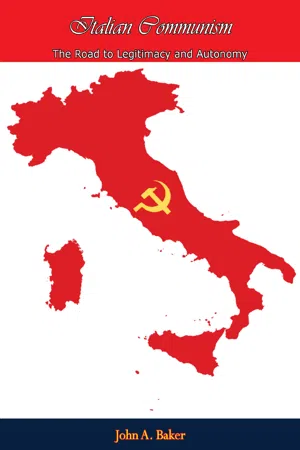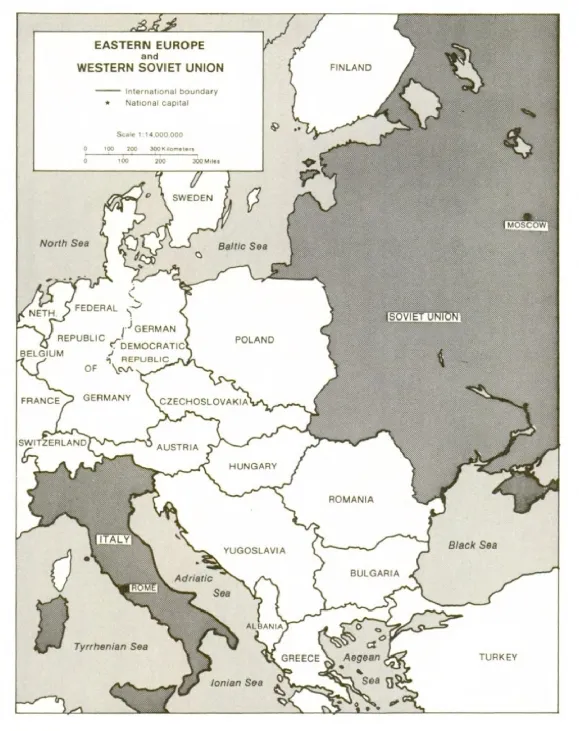![]()
PART ONE—Long Prelude to Power, 1921-76
![]()
I—The Revolutionary Vision
TO GAIN INSIGHT INTO THE PERSPECTIVE of the Italian Communist Party (PCI) on Soviet foreign policy, one necessarily must look first at where the PCI is coming from, where it is going, and how it intends to get there. The PCI, in its quest for power in the Italian political system, and the Soviet Party-State, in its quest for power in the international political system, have certain parallels.
• The PCI and the Soviet Party-State are both challengers in their respective contexts.
• Both consider themselves as providing alternatives to existing socioeconomic systems and proclaim long-term goals of changing them.
For the PCI, internal Italian and European socioeconomic orders are the targets. For the CPSU, the world socioeconomic order and the international political system are the targets.
To achieve their goals, both parties seek acceptance and legitimacy from the dominant elements in the systems they wish to change: The Soviets through summit agreements and high-level visits with major western powers; the PCI through alliances or coalitions with Socialists or Christian Democrats, in Italy and, more widely, in Western Europe. Both the PCI and the Soviet Party-State operate within a pluralist system, yet both have internal organizations that deny pluralism: The Soviet Union, its semi-closed system bloc; the PCI, its disciplined party organization.
Neither possesses the power to achieve its long-term goals alone. Each must husband, develop, manage, and renew its internal organization and scarce economic resources—the sinews of its subsystems within the system.
To challenge the system’s leaders, each must seek allies on the fringes or lower levels of the political system: the Soviets in the growing diversity of the developing world and among the discontented in the developed world; the PCI in proliferating Italian social and issue-advocacy movements, which often provide political initiative and pools of political activists. To obtain short-term objectives or divide its adversaries, each may choose to seek friends within the leading political or economic forces in the system. Each may choose to deal with its chief adversary (the United States in the case of the Soviets; the Christian Democrats in the case of the PCI), or strengthen its links to the adversary’s allies (Europe, for the Soviets; Italian Socialists for the PCI), or pursue some combination of, or alternate between, the two. Détente and deradicalization thus have an affinity for each other.
“Deradicalization”
“Deradicalization” is the name given the process by which a large, revolutionary party or state committed to replacing the existing system evolves toward accommodating to that system. The party or state begins by accepting and participating in the system, rather than rejecting it—no longer boycotting elections or avoiding diplomatic relations. Deradicalization grows as the party or state develops a stake in the existing system. Finally, the challenger gains enough power within the system to modify the socioeconomic order, as the Social Democratic Party and trade unions did in Germany from 1880 to 1914.
For example, as the power and influence of a party expands, the party may become a political force in a parliamentary system. If the opportunity occurs, the party may become a governing force in the political system, initially as a coalition partner with other parties. As a governing partner, committed to the gradual reforms its partners will accept, rather than to its early goal of overthrowing the socioeconomic order, it may even achieve dominant power if it wins the confidence of a majority of the electorate. In an ironic reverse, however, this dominance may require the party to accept the fundamentals of the existing socioeconomic order, if it wishes to hold its power.
So far, in the history of the industrialized West, no socialist, social democratic, or communist party with Marxist roots has achieved governing power without progressing to the point where it no longer proclaims the objective of fundamentally changing or overcoming the capitalist system. So we must conclude that, in Marxist terms, the part of the population that considers itself disadvantaged by the capitalist order and possessed of an embattled “class consciousness” has never reached a voting majority in nations of the industrialized West.
This lack of a voting majority has been, in part, because the industrial working class no longer has the incentive to change the capitalist system, as its more qualified elements benefit from the system. And it also is, in part, because the elements in the population that a modern Marxist might call the non-proletarian working class—such as white collar employees, bank tellers, computer operators, technicians, repairmen, artisans, and small farmers—usually do not view themselves as a class dialectically opposed to the “bourgeoisie.” If they do, their stake in the existing system, and their desire to advance in it, often are enough to direct their political action to reform, rather than change, the system. If enough people have a real stake in the system, the system derives legitimacy from that reality. So parties that challenge the system usually have to settle down for the long haul. What happens to their succeeding generations of elites over that long haul often is the key element of deradicalization.
The concept of deradicalization has its roots in Roberto Michels’ perceptive 1915 study of pre-World War I revolutionary political parties, particularly the largest of them, the German Social Democratic Party (SPD).{10}
Robert Tucker, defining deradicalization as “coming to terms with the existing order,” has argued that expanding revolutionary parties develop institutional interests.{11} They gradually abandon the three original characteristics of radicalism: Rejection of the existing order, a visionary image of an alternative society, and an energetic activism focused on replacing the existing order.{12}
In this movement away from radicalism, a revolutionary party gives priority to (1) its pattern of action, and (2) its political strategy, which reflects less and less of the original radical characteristics. As action and strategy turn more toward pragmatic goals in normal, non-revolutionary situations, the revolutionary party inevitably has to continue or even increase its (3) rhetorical emphasis on the original radical goals. The party must do so in order to control (4) internal conflict within the leadership and membership.{13}
In short, the party’s language, aimed at deterring conflict with the party’s revolutionary traditionalists, tends to lag behind and occasionally retard the evolution of its action and strategy.
The merits of Tucker’s theory have evoked considerable discussion in the 20 years since his views on deradicalization were published. Not surprisingly, some observers have criticized him for applying the original Michels theory of internal political accommodation to the Soviet Union’s external relations with the rest of the world. Others tested the theory on the Italian Communist Party (PCI) and the French Communist Party (PCF)—large communist parties not in power, and hence comparable to the revolutionary German Social Democratic Party (SPD) of 1875-1914 analyzed by Michels.
The PCI, a growing electoral and political force adapting continuously to the existing political system, seemed the best contemporary example. Historical reasons also existed for why the PCI, even before it became a large party after Italy’s liberation in 1945, had a tendency to adapt to and participate in the political system.
Origin of the PCI
The Italian Communist Party (PCI) originated, in the wake of the October 1917 Bolshevik Revolution in Russia, by separating in 1921 from the much larger and older Italian Socialist Party (PSI), the Italian counterpart to the pre-World War I German SPD studied by Michels. Like the SPD, the PSI had experienced a gradual deradicalization before World War II, though it was less significant because of its smaller size, weaker trade union allies, limited political influence in Parliament and in the country, and the lower level of Italian industrialization.
The international communist movement emerged from the European social democratic movement after the October 1917 Russian Revolution and its failed Second International. It started with a Bolshevik inclination to rapid and forceful change, inspired by Lenin’s bold seizure of the revolutionary opportunity in war-weary Russia. Lenin changed the Russian party’s name to Communist to underline the difference between those social democrats willing to work within the “bourgeois democratic” political system, and those who were ready, with him, to force change by replacing that system. In the ruin of the war’s aftermath, with the apparent eclipse of liberal capitalist societies, revolutionaries in Germany and Hungary and elsewhere in Europe thought briefly that the Bolshevik Revolution foreshadowed the pattern of the future. Radical intellectuals like Amadeo Bordiga, first PCI leader (1921-24), dreamed of coming to power on the shoulders of an embattled proletariat.
The radical wing of the Italian Socialist Party, therefore, was susceptible, in the lean years immediately after World War I, to the example of the Bolsheviks’ revolutionary seizure of Russia. With the encouragement of the Comintern,{14} the radical wing split from the main Socialist Party (PSI) at the Socialist Party Congress at Livorno (Leghorn) in 1921, accusing the socialists of the sin of revisionism—the willingness to replace revolution with a long struggle inside the political system.
This division occurred, as Lenin later conceded, just as post-war revolutionary conditions in Europe subsided.
The split in the Socialist Party, weakening the Italian left and frightening the Italian middle class with the specter of radical Bolshevism, helped provide Benito Mussolini—a former socialist—with a platform for his seizure of power in 1922. By late 1926, Mussolini had outlawed the PCI, jailed its new leader, Antonio Gramsci (1924-26), and driven others, including Palmiro Togliatti, its most important leader (1926-64) to date, into exile.
Togliatti’s initial, and perhaps most profoundly political, lesson was that in a country where the working class does not represent a large part of the population and does not fully support the revolutionary party, the extreme right can win broad support for “saving” the nation from radicalism. Togliatti clearly applied that lesson to his later strategy. The working class, and the Communist Party in particular, had to win the sympathy, support, and alliance of other elements of society, including elements of the middle class, to avert anticommunist reaction and achieve power. This objective, very similar to the strategy of the PSI, from which the PCI had split, represented the initial, though tentative, departure from a strategy of insurrection.
Togliatti recommended that since other elements would not risk their lives or interests to bring on a communist dictatorship in place of a fascist one, the PCI’s interim or “transitional” objective should be a democratic system—a republic that guaranteed political rights, including the right to organize a legal Communist Party. In the late twenties, Togliatti and his followers advocated “transitional slogans” for this objective, only to have them rejected sharply by the Soviet masters of the Comintern.{15}
Popular Front Strategy
By 1935, the Comintern had come around to Togliatti’s strategy. The Soviet need to counter the spread of fascism by establishing a European anti-Axis secu...

